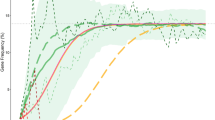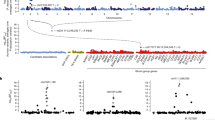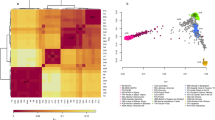Abstract
The Sahel that extends from the Atlantic Ocean to the Ethiopian highland is a historical reservoir of Africa's cultures and grandest populations and a known arena of ancient and recent migrations. We are interested in the issue whether such migrations were also carriers of genetic traits and whether this introgression could be associated with population genetic markers. Based on analysis of Y-chromosome haplogroups, we present evidence that the sickle gene, one of the major protective polymorphisms known in malaria, has in fact found its way only recently to the gene pool of the populations in eastern Sahel. We discuss the possible dynamics of the process and give estimates of the age of the introduction of the S allele into eastern Sahel.
Similar content being viewed by others
Log in or create a free account to read this content
Gain free access to this article, as well as selected content from this journal and more on nature.com
or
References
Pagnier J, Mears JG, Dunda-Belkhodja OD et al: Evidence for the multicentric origin of the sickle cell hemoglobin gene in Africa. Proc Natl Acad Sci USA 81, (1984); 1771–1984.
Lanclos KD, Oner C, Dimovski AJ, Gu YC, Huisman TH : Sequence variations in the 5′ flanking and IVS-II regions of the G gamma- and A gamma-globin genes of ßS chromosomes with five different haplotypes. Blood (1991); 77: 2488–2496.
Oner C, Dimovki A, Olivieri N et al: βs haplotypes in various world population's. Hum Genet (1992); 89: 99–104.
Elhassan AM, Godber MG, Kopec AC, Mourant AE, Tills D, Lehmann H : The inherited blood factors of the Beja of the Sudan. Man (1968); 3: 272.
Bayoumi RA, Taha TS : A study of some genetic characteristics of the Fur and Baggara tribes of the Sudan. AM J Phys Anthropol (1985); 67: 363–370.
Mohammed AO, Attalla B, Bashir FMK et al: The relationship of the sickle cell gene to the ethnic and geographic groups populating the sudan. Community Genet (2006); 9: 113–120.
Cruciani F, Santolamazza P, Shen P et al: A back migration from Asia to sub-Saharan Africa is supported by high-resolution analysis of human Y-chromosome haplotypes. Am J Hum Genet (2002); 70: 1197–1214.
Tishkoff SA, Varkonyl R, Cahinhinan N et al: Haplotype diversity and linkage disequilibrium at human G6PD: Recent origin of alleles that confer malaria resistance. Science (2001); 293: 455–462.
Volkman SK, Barry AE, Lyons EJ et al: Recent origin of Plasmodium falciparum from a single progenitor. Science (2001); 293: 482–483.
Acknowledgements
This work is part of the activities of the BioMalPar European Network of Excellence supported by a European grant (LSHP-CT-2004–503578) from the Priority 1 ‘Life Sciences, Genomics and Biotechnology for Health’ in the 6th Framework Programme.
Author information
Authors and Affiliations
Corresponding author
Rights and permissions
About this article
Cite this article
Bereir, R., Hassan, H., Salih, N. et al. Co-introgression of Y-chromosome haplogroups and the sickle cell gene across Africa's Sahel. Eur J Hum Genet 15, 1183–1185 (2007). https://doi.org/10.1038/sj.ejhg.5201892
Received:
Accepted:
Published:
Issue date:
DOI: https://doi.org/10.1038/sj.ejhg.5201892
Keywords
This article is cited by
-
Y-chromosome E haplogroups: their distribution and implication to the origin of Afro-Asiatic languages and pastoralism
European Journal of Human Genetics (2014)
-
Y-chromosome R-M343 African lineages and sickle cell disease reveal structured assimilation in Lebanon
Journal of Human Genetics (2011)
-
A major Y-chromosome haplogroup R1b Holocene era founder effect in Central and Western Europe
European Journal of Human Genetics (2011)
-
Loss of balancing selection in the βS globin locus
BMC Medical Genetics (2010)



